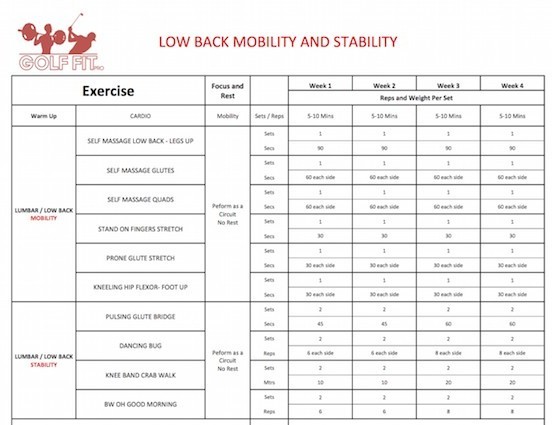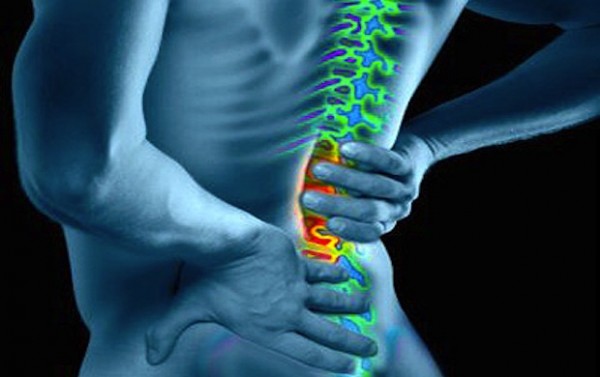Instruction
A Guide to Golf Fitness for Average Golfers

In this series of five articles, I will be offering guidelines for golf-specific physical activity aimed at five different golfing demographics:
This story is for club golfers. The average club golfer has a handicap of 26.5 if they are female, and 14.3 if they are male. They don’t play a lot of golf and have limited time to practice because of their busy schedules. And they usually don’t have the time or the inclination to undertake an extensive physical regimen to improve their golf. But that doesn’t mean that the average golfer can’t benefit from some work on their body.
It is difficult to say exactly how average golfers can benefit from a fitness routine without a thorough physical screening and lifestyle questionnaire, which identifies the areas individuals need to work on. But there are a few common issues that tend to crop up again and again in club golfers that come through our academy.
Let’s have a look at the most common complaints and the methods we use to help.
The Issue: “I have pain in my lower back”
Lots of people play golf in pain. In fact, a 2006 study on golfer health conducted by Golf Digest showed that a staggering 64 percent of golfers suffer from low back pain of some description.
The Solution: Strength, Mobility + Postural Awareness and Control
Once a golfer has been cleared for serious spinal pathology and we are given the green light, we golf fitness experts get to work on making them stronger and more mobile. We often begin with awareness and activation drills for the core, spine and posture in general, along with mobility work on the muscles attaching to the pelvis that are pulling the low back into an uncomfortable position. On the hit list are invariably hip flexors, quads, deep glutes and hamstrings. While working on awareness and mobility, we also start to introduce basic strength exercises for the core, glutes, hamstrings and low back.
See below for a basic program of mobility and stability exercises for key muscles surrounding the pelvis and spine. The ideal equipment for this is a Golf Posture Training Kit, but you can also use a tennis ball, baseball, foam roller and a piece of rubber tubing or theraband.

Release and stretching for the low back, glutes, quads and hip flexors. Stability/strength exercises for the glutes. Click the image to enlarge it.
The Issue: “I want to hit it farther”
The standard club golfer always wants to squeeze a few extra yards out of his or her driver and we can certainly help, but maybe not in the way that you might think we can.
The Solution: Movement Patterns and Sequencing
Rather than simply attempting to increase club head speed with loaded rotational core exercises, we first look at improving the efficiency of the golf swing itself. We do this by analyzing the swing and then prescribing movement pattern drills. This will not only increase club head speed, but also help golfers get more compression and better launch conditions. As we start to make significant progress in this area, we can then look at strength exercises to maximize the new, more efficient action. Below are a couple of the more basic movement pattern drills I use.
I’m pictured using the a 2XU Ramsay Posture Belt and micro power band, but you can also use a piece of rubber tubing for the hands and another tied around the knees.
The Issue: “I can’t swing it the way my coach wants me to”
In my experience, mobility is often the biggest inhibitor for club golfers when trying to get into the swing positions that their coach is teaching them. If the player does not have the range of motion in a particular joint or length in a particular muscle, then it will be impossible for them to get into the right position without a lot of compensation from other parts of the body.
The Solution: Self Massage, Functional Stretching and Activation Drills
Trail shoulder position (right shoulder for righties, left shoulder for lefties) is an area that is particularly affected by lack of mobility and also has a massive influence on shaft and club face position throughout the swing. Tight pectorals (pec major and minor) and inactive and/or weak “scap control muscles” (serratus anterior, mid and low traps, and the rotator cuff muscles) work together to drag the shoulder forward. From here it is difficult to set the shoulder correctly, and therefore arm and club head in the correct position in takeaway and at the top of the backswing.
We prescribe self massage release and stretching for the pecs and a series of activation drills for the scap control muscles. These can be performed in golf posture to help the player transfer the newfound mobility, control and strength around their shoulder directly into their golf swing.
See below for a mini program of scapula/shoulder setting exercises. Again, you can use a tennis ball, baseball and some rubber tubing to perform these simple exercises.
To access a free exercise guide for the mini programs in this article, you can download the Golf Fit Pro app for iOS and Android. Equipment, training programs and more are available on the Golf Fit Pro website.
- LIKE38
- LEGIT5
- WOW4
- LOL1
- IDHT1
- FLOP7
- OB2
- SHANK28
Instruction
Clement: Laid-off or perfect fade? Across-the-line or perfect draw?

Some call the image on the left laid off, but if you are hitting a fade, this could be a perfect backswing for it! Same for across the line for a draw! Stop racking your brain with perceived mistakes and simply match backswing to shot shape!
- LIKE0
- LEGIT0
- WOW0
- LOL0
- IDHT0
- FLOP0
- OB0
- SHANK1
Instruction
The Wedge Guy: The easiest-to-learn golf basic

My golf learning began with this simple fact – if you don’t have a fundamentally sound hold on the golf club, it is practically impossible for your body to execute a fundamentally sound golf swing. I’m still a big believer that the golf swing is much easier to execute if you begin with the proper hold on the club.
As you might imagine, I come into contact with hundreds of golfers of all skill levels. And it is very rare to see a good player with a bad hold on the golf club. There are some exceptions, for sure, but they are very few and very far between, and they typically have beat so many balls with their poor grip that they’ve found a way to work around it.
The reality of biophysics is that the body moves only in certain ways – and the particulars of the way you hold the golf club can totally prevent a sound swing motion that allows the club to release properly through the impact zone. The wonderful thing is that anyone can learn how to put a fundamentally sound hold on the golf club, and you can practice it anywhere your hands are not otherwise engaged, like watching TV or just sitting and relaxing.
Whether you prefer an overlap, interlock or full-finger (not baseball!) grip on the club, the same fundamentals apply. Here are the major grip faults I see most often, in the order of the frequency:
Mis-aligned hands
By this I mean that the palms of the two hands are not parallel to each other. Too many golfers have a weak left hand and strong right, or vice versa. The easiest way to learn how to hold the club with your palms aligned properly is to grip a plain wooden ruler or yardstick. It forces the hands to align properly and shows you how that feels. If you grip and re-grip a yardstick several times, then grip a club, you’ll see that the learning curve is almost immediate.
The position of the grip in the upper/left hand
I also observe many golfers who have the butt of the grip too far into the heel pad of the upper hand (the left hand for right-handed players). It’s amazing how much easier it is to release the club through the ball if even 1/4-1/2″ of the butt is beyond the left heel pad. Try this yourself to see what I mean. Swing the club freely with just your left hand and notice the difference in its release from when you hold it at the end of the grip, versus gripping down even a half inch.
To help you really understand how this works, go to the range and hit shots with your five-iron gripped down a full inch to make the club the same length as your seven-iron. You will probably see an amazing shot shape difference, and likely not see as much distance loss as you would expect.
Too much lower (right) hand on the club
It seems like almost all golfers of 8-10 handicap or higher have the club too far into the palm of the lower hand, because that feels “good” if you are trying to control the path of the clubhead to the ball. But the golf swing is not an effort to hit at the ball – it is a swing of the club. The proper hold on the club has the grip underneath the pad at the base of the fingers. This will likely feel “weak” to you — like you cannot control the club like that. EXACTLY. You should not be trying to control the club with your lower/master hand.
Gripping too tightly
Nearly all golfers hold the club too tightly, which tenses up the forearms and prevents a proper release of the club through impact. In order for the club to move back and through properly, you must feel that the club is controlled by the last three fingers of the upper hand, and the middle two fingers of the lower hand. If you engage your thumbs and forefingers in “holding” the club, the result will almost always be a grip that is too tight. Try this for yourself. Hold the club in your upper hand only, and squeeze firmly with just the last three fingers, with the forefinger and thumb off the club entirely. You have good control, but your forearms are not tense. Then begin to squeeze down with your thumb and forefinger and observe the tensing of the entire forearm. This is the way we are made, so the key to preventing tenseness in the arms is to hold the club very lightly with the “pinchers” — the thumbs and forefingers.
So, those are what I believe are the four fundamentals of a good grip. Anyone can learn them in their home or office very quickly. There is no easier way to improve your ball striking consistency and add distance than giving more attention to the way you hold the golf club.
More from the Wedge Guy
- The Wedge Guy: Golf mastery begins with your wedge game
- The Wedge Guy: Why golf is 20 times harder than brain surgery
- The Wedge Guy: Musings on the golf ball rollback
- LIKE86
- LEGIT13
- WOW6
- LOL1
- IDHT0
- FLOP4
- OB1
- SHANK8
Instruction
Clement: Stop ripping off your swing with this drill!

Not the dreaded headcover under the armpit drill! As if your body is defective and can’t function by itself! Have you seen how incredible the human machine is with all the incredible feats of agility all kinds of athletes are accomplishing? You think your body is so defective (the good Lord is laughing his head off at you) that it needs a headcover tucked under the armpit so you can swing like T-Rex?
- LIKE0
- LEGIT2
- WOW2
- LOL0
- IDHT0
- FLOP0
- OB0
- SHANK2
-

 19th Hole2 weeks ago
19th Hole2 weeks agoDave Portnoy places monstrous outright bet for the 2024 Masters
-

 19th Hole3 days ago
19th Hole3 days agoJustin Thomas on the equipment choice of Scottie Scheffler that he thinks is ‘weird’
-

 19th Hole2 weeks ago
19th Hole2 weeks agoTiger Woods arrives at 2024 Masters equipped with a putter that may surprise you
-

 19th Hole3 days ago
19th Hole3 days ago‘Absolutely crazy’ – Major champ lays into Patrick Cantlay over his decision on final hole of RBC Heritage
-

 19th Hole2 weeks ago
19th Hole2 weeks agoTwo star names reportedly blanked Jon Rahm all week at the Masters
-

 19th Hole1 week ago
19th Hole1 week agoReport: LIV Golf identifies latest star name they hope to sign to breakaway tour
-

 19th Hole1 week ago
19th Hole1 week agoNeal Shipley presser ends in awkward fashion after reporter claims Tiger handed him note on 8th fairway
-

 19th Hole1 week ago
19th Hole1 week agoBrandel Chamblee has ‘no doubt’ who started the McIlroy/LIV rumor and why



















other paul
Jun 20, 2015 at 9:09 am
If you play with lower back pain then look up Kelvin miyahira. I started swinging more like he describes and my back pain from golf is gone. Back pain from lifting heavy things in my work did not go away…
Patricknorm
Jun 19, 2015 at 5:28 am
Excellent article Nick. I worked pretty hard this past winter and spring to increase my core strength and flexibility. I’ve had many surgeries do to playing sports at a high (pro)level. I also sought out a personal trainer to make certain I was on the right path to my goals.
What I found, do my issues with a tender back ( due to multiple surgeries on knee and hip), was that when I get tired, my legs don’t help as much as they should or are able.
I can’t run or even ride a bike because I can’t bend my right knee past 90 degrees. Is there a drill / exercise you can recommend for a lefty, with a strong sugerically repaired right knee ( 5 procedures, last being a replacement) to increase or maintain strength in my legs?
Keep up the good work Nick . Just ignore the shanks.